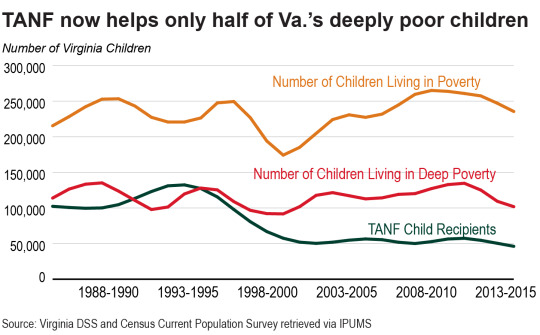June 25, 2018
Remaining Balance in State TANF Funds Should Be Used to Strengthen the Safety Net
Virginia’s new budget finances multiple measures to help improve the lives of Virginians. The budget funds the extension of health care coverage to nearly 400,000 newly eligible Virginians, and it funds increased salaries for teachers, nurses, counselors, and other staff in Virginia’s public schools. However, lawmakers failed to continue the progress made over the past two years in increasing support for Virginia’s poorest families with children, despite the serious erosion in Temporary Assistance for Needy Families (TANF) benefits over the last two decades.
TANF block grants from the federal government – paired with state dollars – provide a safety net for low-income families by funding child care, work-related support, and cash assistance. These kinds of services support parents while they work and promote stability for their kids. Despite these positive results, the value of TANF’s benefits has significantly eroded over time compared to the rising costs of living. In addition, states have used residual TANF funds for other programs rather than to fund cost-of-living increases in TANF benefits.
Since TANF was created in 1996, federal funding levels have not been adjusted to maintain purchasing power, and states have neglected to adjust their TANF benefits to keep up with the rising cost of living. In most states, a family of three’s benefits are at least 20 percent less than they were in 1996 when adjusted for inflation. And although Virginia is among nine states to increase benefits in recent years, these small adjustments still leave a family of three with only $419 in cash benefits at most.
That’s 24.6 percent of the federal poverty line and 24 percent less cash benefits than in 1997. It covers less than half of the Fair Market Rent for a two bedroom apartment in Virginia. And low income families who qualify for TANF are not prioritized for housing assistance. This is simply not enough for families to get by, let alone get ahead.
In 2016, Virginia used 61 percent of TANF funds for core TANF benefits – child care, cash assistance, and work support. But like most states, Virginia has shifted funds away from core TANF services, using them elsewhere for grants to nonprofits, tax credits, early childhood education, child welfare, and the like. During the most recent legislative session, Virginia allocated nearly $14 million of TANF funds to nonprofit grants and local governments. While these programs are worthy recipients of funding, the state’s TANF funds are supporting less families than ever and are providing a weakening safety net of cash assistance for working poor families. In 2001, 33 in 100 poor families received TANF cash assistance, but that fell to 19 out of 100 families in 2016.

The good news is that a substantial available TANF balance is still expected. Policymakers should consider using these funds for the core purposes of TANF and, in particular, lawmakers should boost cash assistance for families with very low incomes. Research shows that economic security programs like cash assistance result in long-term improvement in children’s health outcomes, academic performance, and lifetime earnings because it helps families live in safer neighborhoods, choose healthier foods, get access to transportation – which can help finding and maintaining employment – and reduce poverty-related stress.
There is a dire need for reinvestment in TANF’s core benefits, especially cash assistance, and the remaining balance presents lawmakers with an opportunity to better serve more low-income families. Putting more money into these programs is crucial to alleviating poverty in Virginia. By prioritizing funding and restoring the value of TANF benefits, lawmakers can help strengthen children’s futures, and build a more just and equitable economy.
Category:
Economic Opportunity
